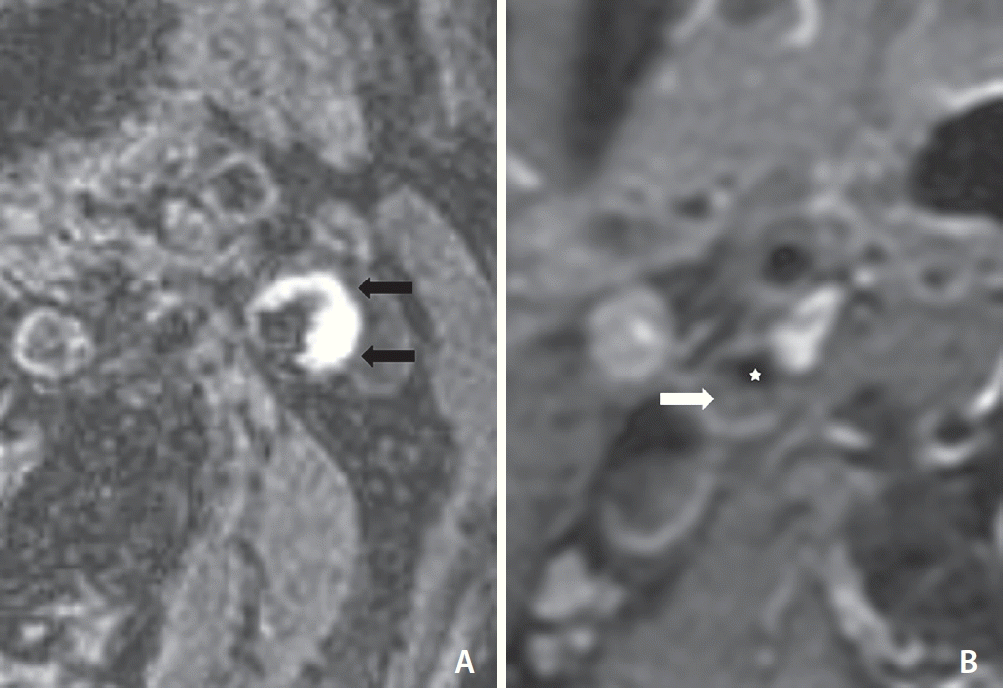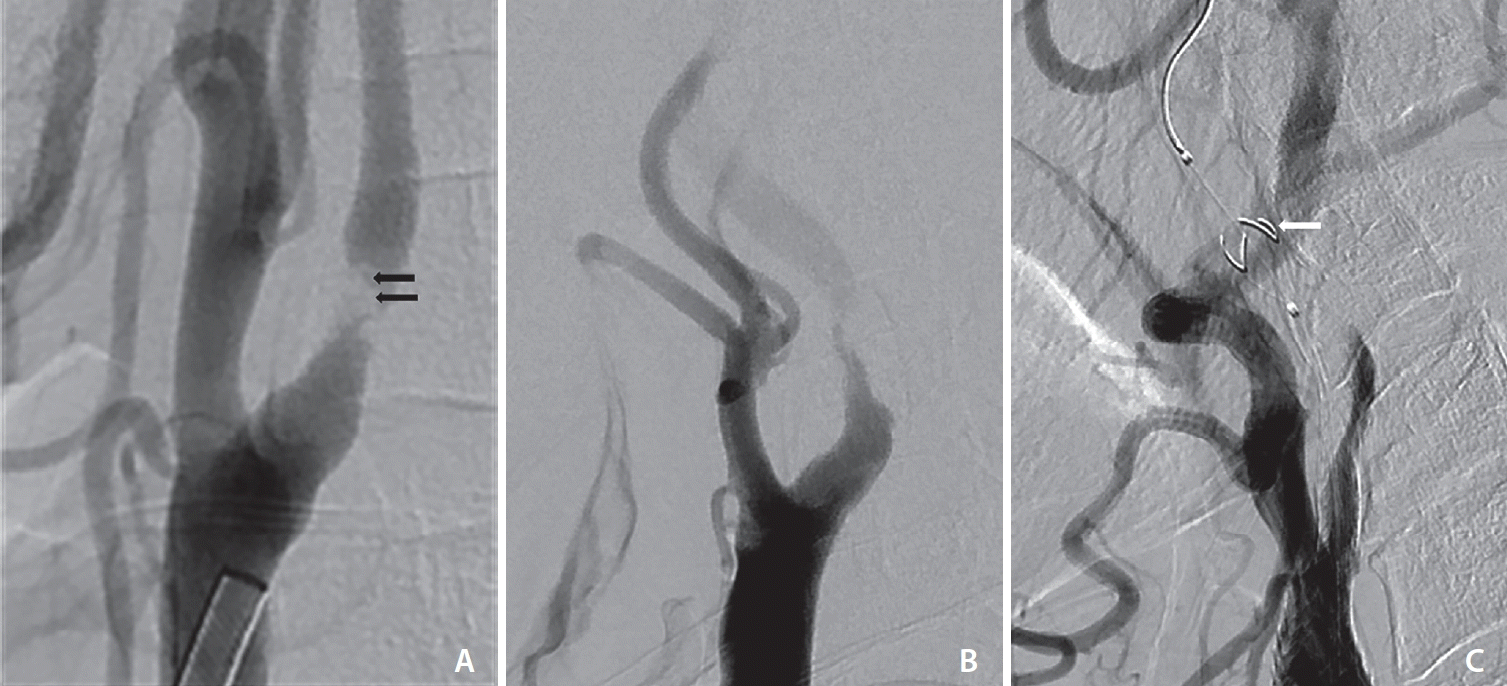1. Flaherty ML, Kissela B, Khoury JC, Alwell K, Moomaw CJ, Woo D, et al. Carotid artery stenosis as a cause of stroke. NeuroePidemiology. 2013; 40:36–41.

2. Mantese VA, Timaran CH, Chiu D, Begg RJ, Brott TG; CREST Investigators. The carotid revascularization endarterectomy versus stenting trial (CREST): stenting versus carotid endarterectomy for carotid disease. Stroke. 2010; 41(10 Suppl):S31–S34.
3. Yadav JS, Wholey MH, Kuntz RE, Fayad P, Katzen BT, Mishkel GJ, Stenting and Angioplasty with Protection in Patients at High Risk for Endarterectomy Investigators, et al. Protected carotid-artery stenting versus endarterectomy in high-risk patients. N Engl J Med. 2004; 351:1493–1501.

4. Yamada K, Kawasaki M, Yoshimura S, Enomoto Y, Asano T, Minatoguchi S, et al. Prediction of silent ischemic lesions after carotid artery stenting using integrated backscatter ultrasound and magnetic resonance imaging. Atherosclerosis. 2010; 208:161–166.

5. Zhao G, Tang X, Tang H, Lin J, Sun W, Fan Z, et al. Recent intraplaque hemorrhage is associated with a higher risk of ipsilateral cerebral embolism during carotid artery stenting. World Neurosurg. 2020; 137:e298–e307.

6. Yoon W, Kim SK, Park MS, Chae HJ, Kang HK. Safety of protected carotid artery stenting in patients with severe carotid artery stenosis and carotid intraplaque hemorrhage. AJNR Am J Neuroradiol. 2012; 33:1027–1031.

7. Kwon SM, Cheong JH, Lee SK, Park DW, Kim JM, Kim CH. Risk factors for developing large emboli following carotid artery stenting. J Korean Neurosurg Soc. 2013; 53:155–160.

8. Wimmer NJ, Yeh RW, Cutlip DE, Mauri L. Risk prediction for adverse events after carotid artery stenting in higher surgical risk patients. Stroke. 2012; 43:3218–3224.

9. Grundy SM, Stone NJ, Bailey AL, Beam C, Birtcher KK, Blumenthal RS, et al. 2018 AHA/ACC/AACVPR/AAPA/ABC/ACPM/ADA/ AGS/APhA/ASPC/NLA/PCNA guideline on the management of blood cholesterol: a report of the American College of Cardiology/American Heart Association Task Force on clinical practice guidelines. Circulation. 2019; 139:e1082–e1143.
10. Li D, Qiao H, Han Y, Han H, Yang D, Cao J, et al. Histological validation of simultaneous non-contrast angiography and intraplaque hemorrhage imaging (SNAP) for characterizing carotid intraplaque hemorrhage. Eur Radiol. 2021; 31:3106–3115.

11. Takaya N, Yuan C, Chu B, Saam T, Underhill H, Cai J, et al. Association between carotid plaque characteristics and subsequent ischemic cerebrovascular events: a prospective assessment with MRI--initial results. Stroke. 2006; 37:818–823.

12. Chung GH, Jeong JY, Kwak HS, Hwang SB. Associations between cerebral embolism and carotid intraplaque hemorrhage during protected carotid artery stenting. AJNR Am J Neuroradiol. 2016; 37:686–691.

13. Geiger MA, Flumignan RLG, Sobreira ML, Avelar WM, Fingerhut C, Stein S, et al. Carotid plaque composition and the importance of non-invasive in imaging stroke prevention. Front Cardiovasc Med. 2022; 9:885483.

14. Zhang Y, Bai Y, Xie J, Wang J, He L, Huang M, et al. Carotid plaque components and other carotid artery features associated with risk of stroke: a systematic review and meta-analysis. J Stroke Cerebrovasc Dis. 2022; 31:106857.

15. Che F, Mi D, Wang A, Ju Y, Sui B, Geng X, et al. Extracranial carotid plaque hemorrhage predicts ipsilateral stroke recurrence in patients with carotid atherosclerosis - a study based on high-resolution vessel wall imaging MRI. BMC Neurol. 2022; 22:237.

16. Jeong JY, Kwak HS, Hwang SB, Chung GH. The safety of protected carotid artery stenting in patients with unstable plaque on carotid high-resolution MR imaging. J Korean Soc Radiol. 2018; 78:380–388.

17. Zhao X, Hippe DS, Li R, Canton GM, Sui B, Song Y, CARE-II Study Collaborators, et al. Prevalence and characteristics of carotid artery high-risk atherosclerotic plaques in Chinese patients with cerebrovascular symptoms: a Chinese atherosclerosis risk evaluation II study. J Am Heart Assoc. 2017; 6:e005831.

18. Sanghvi D, Shrivastava M. Carotid plaque imaging: strategies beyond stenosis. Ann Indian Acad Neurol. 2022; 25:11–14.

19. Poppe AY, Jacquin G, Roy D, Stapf C, Derex L. Tandem carotid lesions in acute ischemic stroke: mechanisms, therapeutic challenges, and future directions. AJNR Am J Neuroradiol. 2020; 41:1142–1148.

20. Flaherty ML, Flemming KD, McClelland R, Jorgensen NW, Brown RD Jr. Population-based study of symptomatic internal carotid artery occlusion: incidence and long-term follow-up. Stroke. 2004; 35:e349–e352.
21. Tomoyose R, Tsumoto T, Hara K, Miyazaki Y, Tokunaga S, Yasaka M, et al. Mechanical thrombectomy and carotid artery stenting for stenosis of the internal carotid artery with free-floating thrombosis: illustrative case. J Neurosurg Case Lessons. 2021; 2:CASE21338.

22. Bhogal P, AlMatter M, Aguilar Pérez M, Bäzner H, Henkes H, Hellstern V. Carotid stenting as definitive treatment for free floating thrombus-review of 7 cases. Clin Neuroradiol. 2021; 31:449–455.

23. Yoshimura S, Yamada K, Kawasaki M, Asano T, Kanematsu M, Takamatsu M, et al. High-intensity signal on time-of-flight magnetic resonance angiography indicates carotid plaques at high risk for cerebral embolism during stenting. Stroke. 2011; 42:3132–3137.

24. Jeon SY, Lee JM. Protected carotid artery stenting in patients with severe stenosis. Medicine (Baltimore). 2022; 101:e30106.

25. Bijuklic K, Wandler A, Varnakov Y, Tuebler T, Schofer J. Risk factors for cerebral embolization after carotid artery stenting with embolic protection: a diffusion-weighted magnetic resonance imaging study in 837 consecutive patients. Circ Cardiovasc Interv. 2013; 6:311–316.

26. Rosenkranz M, Thomalla G, Havemeister S, Wittkugel O, Cheng B, Krützelmann A, et al. Older age and greater carotid intima-media thickness predict ischemic events associated with carotidartery stenting. Cerebrovasc Dis. 2010; 30:567–572.

27. Gröschel K, Ernemann U, Schnaudigel S, Wasser K, Nägele T, Kastrup A. A risk score to predict ischemic lesions after protected carotid artery stenting. J Neurol Sci. 2008; 273:112–115.

28. Khan M, Qureshi AI. Factors associated with increased rates of post-procedural stroke or death following carotid artery stent placement: a systematic review. J Vasc Interv Neurol. 2014; 7:11–20.
29. Sayeed S, Stanziale SF, Wholey MH, Makaroun MS. Angiographic lesion characteristics can predict adverse outcomes after carotid artery stenting. J Vasc Surg. 2008; 47:81–87.

30. Barnett HJ, Meldrum HE, Eliasziw M; North American Symptomatic Carotid Endarterectomy Trial (NASCET) Collaborators. The appropriate use of carotid endarterectomy. CMAJ. 2002; 166:1169–1179.
31. Alloubani A, Nimer R, Samara R. Relationship between hyperlipidemia, cardiovascular disease and stroke: a systematic review. Curr Cardiol Rev. 2021; 17:e051121189015.

32. Alloubani A, Saleh A, Abdelhafiz I. Hypertension and diabetes mellitus as a predictive risk factors for stroke. Diabetes Metab Syndr. 2018; 12:577–584.

33. Karkos CD, Karamanos DG, Papazoglou KO, Demiropoulos FP, Papadimitriou DN, Gerassimidis TS. Thirty-day outcome following carotid artery stenting: a 10-year experience from a single center. Cardiovasc Intervent Radiol. 2010; 33:34–40.






 PDF
PDF Citation
Citation Print
Print




 XML Download
XML Download